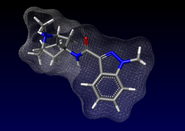 | |
 | |
| Clinical data | |
|---|---|
| Trade names | Kytril, Sancuso, others |
| AHFS/Drugs.com | Monograph |
| MedlinePlus | a601211 |
| License data | |
| Pregnancy category |
|
| Routes of administration | By mouth, intravenous, transdermal |
| ATC code | |
| Legal status | |
| Legal status | |
| Pharmacokinetic data | |
| Bioavailability | 60% |
| Protein binding | 65% |
| Metabolism | Hepatic |
| Elimination half-life | 3–14 hours |
| Excretion | Renal 11–12%, faecal 38% |
| Identifiers | |
| |
| CAS Number | |
| PubChem CID | |
| IUPHAR/BPS | |
| DrugBank | |
| ChemSpider | |
| UNII | |
| KEGG | |
| ChEBI | |
| ChEMBL | |
| CompTox Dashboard (EPA) | |
| ECHA InfoCard | 100.212.327 |
| Chemical and physical data | |
| Formula | C18H24N4O |
| Molar mass | 312.417 g·mol−1 |
| 3D model (JSmol) | |
| |
| |
| | |
Granisetron is a serotonin 5-HT3 receptor antagonist used as an antiemetic to treat nausea and vomiting following chemotherapy and radiotherapy. Its main effect is to reduce the activity of the vagus nerve, which is a nerve that activates the vomiting center in the medulla oblongata. It does not have much effect on vomiting due to motion sickness. This drug does not have any effect on dopamine receptors or muscarinic receptors.
Granisetron was developed by chemists working at the British drug company Beecham c. 1985 and is available as a generic. It is produced by Roche Laboratories under the trade name Kytril. The drug was approved in the United Kingdom in 1991 and in United States in 1994 by the FDA.
A granisetron transdermal patch with the trade name Sancuso was approved by the US FDA on September 12, 2008.[1] Sancuso is manufactured by 3M Drug Delivery Systems for Kyowa Kirin, Inc.
It was patented in 1985 and approved for medical use in 1991.[2] It is on the World Health Organization's List of Essential Medicines.[3]
- ^ "FDA Approves Sancuso, the First and Only Patch for Preventing Nausea and Vomiting in Cancer Patients Undergoing Chemotherapy". PRNewswire. September 12, 2008.
- ^ Fischer J, Ganellin CR (2006). Analogue-based Drug Discovery. John Wiley & Sons. p. 448. ISBN 9783527607495.
- ^ World Health Organization (2021). World Health Organization model list of essential medicines: 22nd list (2021). Geneva: World Health Organization. hdl:10665/345533. WHO/MHP/HPS/EML/2021.02.